21 DIY Sensory Activities for Infants
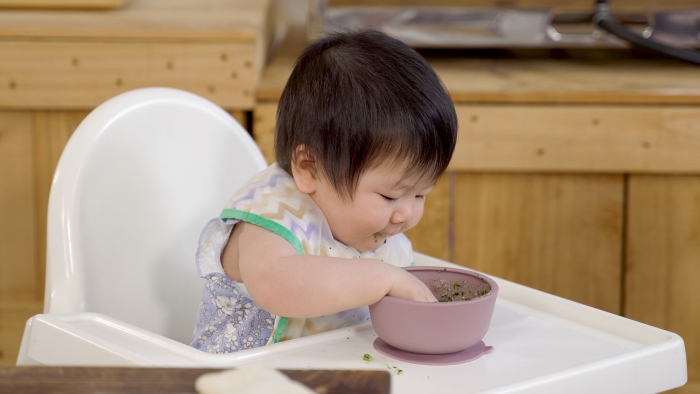
This post may contain affiliate links; please see our terms of use for details.
- A sensory activity is anything that will stimulate your baby’s cognitive and language development, laying the groundwork for them to learn problem-solving, motor skills, and explore creative and abstract thinking.
- There are seven senses for sensory processing in children: sight, smell, sound, touch, taste, balance, and body awareness.
- Sensory play stimulates one or many of your baby’s senses. It’s how they learn to process sensation and interpret their world.
- Sensory play opportunities are everywhere. Everyday items from around the house–like ice cubes, cotton balls, or shaving cream–often provide the most engaging and exciting sensory experiences for your little one.
Sensory play activities are anything that will stimulate your child’s sense of touch, taste, smell, sight, or hearing – plus balance and body awareness, which will be discussed soon. The purpose is to encourage your baby’s sensory development, which is how they will observe and make sense of their world. It promotes their cognitive development, language skills, and socialization.
Best of all, sensory play is incredibly fun and entertaining for little ones. They will spend hours engaging in messy play, exploration, and experimentation. We’ve gathered some effortless, inexpensive ways to create a variety of sensory play activities for you and your little one to enjoy.
What Are the Seven Senses?
While most are familiar with five senses, there are seven senses when it comes to sensory development in children. Let’s discuss each so that you can start to build sensory experiences that stimulate each of your child’s senses.
- Touch – The balance and body awareness senses introduced above go hand in hand with tactile sensations, called touch. Many sensory exploration activities will combine all three as they develop together. This is how your baby begins to understand how they can alter or control physical objects. Tactile play for infants can incorporate textures, pressure, temperature, and vibrations.
- Balance – The vestibular system is located in the inner ear and focuses on balance and movement. Getting your child’s head into many different positions will help strengthen the vestibular system by activating various receptors in the ear. This is crucial in early learning as it aids in helping little ones stand, walk, and sit up without falling. Vestibular-focused activities include rolling around, hanging, swinging, and jumping.
- Body Awareness – The proprioception system is related to body awareness. It is how our physical bodies exist in space and how various body parts relate to and work together. Think about how much coordination and skill are required to pick up a whole gallon of milk and pour it into a cup. Babies develop their sense of spatial awareness through activities like pushing, pulling, and jumping.
- Sight – Babies love sight stimulation and it’s one of the easiest for them to participate in before they’re strong enough to sit up and interact with toys. Reading books, lots of facetime, and peek-a-boo are ideal visual activities for babies.
- Hearing – Auditory stimulation sets the groundwork for language development. Babies find comforting sensory stimulation in the sound of their mother’s heartbeat, soft music, a singing plush “lovey” toy, or a rattle. Conversely, babies love to wiggle and dance to upbeat music for active play.
- Smell – Your baby’s sense of smell comes from olfactory receptors in the back of her nose. This sense also goes hand in hand with the gustatory system, the perception of taste and flavor. Along with their mother’s smell, babies love to smell fresh laundry, flowers, a bubble bath, food, and other items from around the house.
- Taste – Combining activities that babies can smell and taste, known as the gustatory system, is an excellent way to stimulate their senses. Try offering your baby a wide variety of foods (if they are age appropriate) and encourage them to explore.
Allow your baby to touch, mash, smell, and feel the food before they taste it. This will make them more inclined to be open to trying new foods. Make sure your pediatrician has approved introducing solid foods into your baby’s diet first.
These seven senses are referred to as sensory processing. They help developing infants round out their ability to perceive, interpret, connect, and interact with the world.
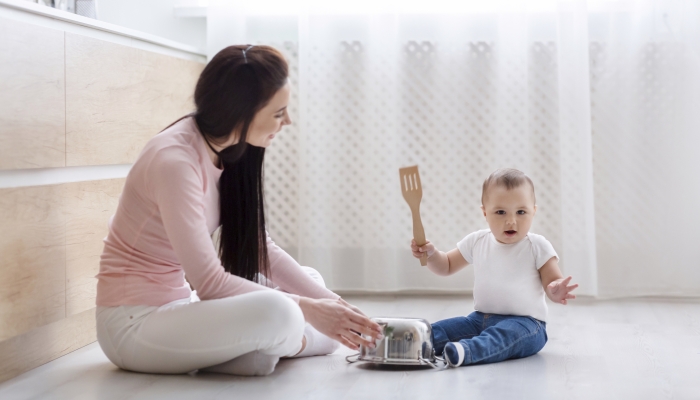
Why Is It Important to Encourage Sensory Play in Infants?
Sensory play is important for many reasons that will change and evolve as your child grows. Below we cover the benefits of sensory play and how it encourages your baby’s development through their first year.
Babies 0-6 Months
Your baby’s brain develops new connections through play. Sensory play is open-ended, interactive play that teaches them how to observe, understand, and respond to stimuli.
Babies are happiest with simple sensory experiences like touching different materials, hearing how certain materials make sounds, and looking at the faces of people they love. Research shows that early visual and motor stimulation plays a role in developing language and math skills later in life.
Babies 6-12 Months
Babies approaching a year start to develop their thinking abilities and will try to do things for themselves. They begin to learn concepts, like the time of day and opposites, and show a strong desire to communicate.
Sensory play assists in building nerve connections in the brain. Around six to twelve months, they start developing the ability to focus and block out distractions, a milestone that can often go unnoticed. As they approach one year, your baby will focus and engage in hands-on activities, helping them build cognitive thinking skills.
By giving your baby the freedom to explore, play, get messy, and make their own fun, you encourage him to become a solid learner and develop autonomy. Giving a child the opportunity to play and figure things out for themselves at their own pace promotes a natural sense of curiosity and persistence.
These skills go a long way in life, from succeeding in school, in career, and even interpersonal relationships. As your child approaches one year, you can begin to incorporate these sensory toys for toddlers.
10 Sensory Activities for Infants 0-6 Months
Many of these sensory activities are inexpensive (check out this DIY sensory room on a budget) and involve items in your home and everyday chores. The beauty of sensory play is that they can get all the stimulation they need by soaking in their environment.
Be alert that the activities are age-appropriate for your baby. For example, babies start putting everything in their mouths around seven months old, so be mindful of small items around them during sensory play.
- Peek-a-boo is the quintessential infant sensory activity, and they can’t get enough of it. It helps them develop object permanence and facilitates their sense of sight, sound, touch, smell, and body awareness.
- Airplane spoon is another classic baby game that they find endlessly entertaining. Babies love to watch their spoon take flight, zip, and zoom around before landing in their mouths for a yummy and delicious sensory treat. This develops their sight, sound, touch, taste, smell, and body awareness.
- High-contrast images, like the ones found in black and white books for newborns, stimulate your baby’s optic nerve and sight development. You can also print high-contrast, visually interesting images to hang around your baby’s room and play areas.
- Stop and smell the flowers. Although it may be hard to tell, babies love to take in the smell of flowers, grass, freshly baked bread, warm laundry, and lots of different objects in their environment. Try to be cognizant in your daily tasks, to look for opportunities that give your baby the chance to see, smell, and touch different textures safely and under your supervision.
- Take a walk and savor the sensory opportunities around you. Call attention to and mimic the bird’s chirping and singing, point out brightly colored flowers, and allow your baby to sniff and feel them. Narrating the process as you go will stimulate language development as well. This engages their sense of touch, taste, smell, sight, hearing, and body awareness.
- Tummy time is an excellent way for babies to work on their sense of balance when they have little muscle control. Not only does it strengthen their neck and back muscles but placing toys or a colorful mat in front of them will encourage them to explore and develop their fine motor skills, balance, body awareness, touch, sight, and hearing.
- Baby food pacifiers are an excellent way to introduce tastes safely to babies. They are little food pouches with holes that your baby can chew and suck on without fear of choking. It’s an excellent way to ease your baby into eating solid foods around four months old, or whenever your pediatrician approves.
- Touch and feel books are a fun and stimulating tactile sensory experience that babies and toddlers love. Help guide their hands, touching different textures and narrate their experience. For example, “Feel the bunny’s soft fur. Feel the turtle’s bumpy shell.”
- Clapping and drumming activities are enjoyable for babies even when they cannot do it independently. Put on some music with a beat that allows you to guide your baby’s hands into clapping along. This is an excellent way to develop their vestibular sense while stimulating their hearing, sight, balance, and body awareness.
- Infant swings and baby carriers are great ways to develop your baby’s sense of balance and that crucial inner ear vestibular development. Wearing your baby while doing simple chores and activities, bending down to pick up objects, or leaning from side to side all aid in this development. In fact, swings help with this too, plus they’re incredibly soothing and help get newborns to sleep.
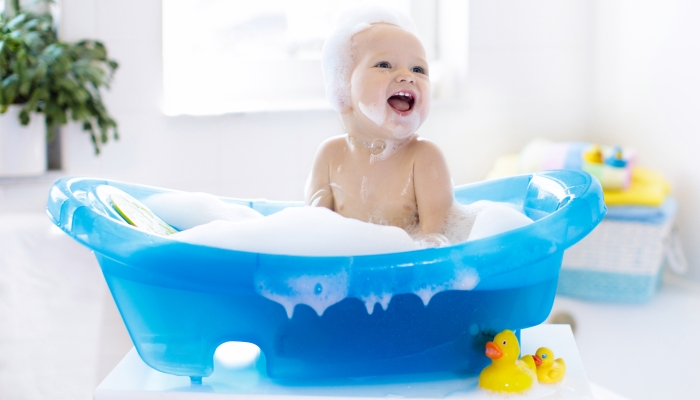
11 Sensory Activities for Infants 6-12 Months
- A wooden spoon and a small pot is a classic way for your baby to explore sound through play. The adults, however, may want to guard their ears. As your baby grows into toddlerhood, you can incorporate many other fun musical instruments. This will develop their sense of hearing, touch, sight, balance, and body awareness.
- Teething toys serve a clear purpose, but they also allow for a lot of exploration of baby’s sense of taste, smell, hearing, touch, sight, and body awareness senses.
- Shaving cream or finger paints are a fun, messy tactile sensory activity. This is ideal for babies who don’t put everything in their mouths. Make sure the paints or shaving cream is non-toxic. This stimulates your baby’s sense of sight, sound, smell, touch, and body awareness.
- Bath play is another excellent way to turn an everyday chore into a fun sensory activity. Give your baby sponges, plastic cups of different sizes, bathtub paints, and these pop tubes for a fun bathtime experience stimulating baby’s touch, balance, body awareness, sight, sound, and smell senses.
- Blow bubbles and pop them for hours of entertainment. There are many ways to craft bubble sensory activities that stimulate your baby’s sense of touch, sight, smell, hearing, balance, and spatial awareness.
- Sniff and smell is fun for babies that can sit up and smell items like the spices in your kitchen. Find one that really interests her and sprinkle it on some fruit or yogurt to taste. This stimulates her sense of smell, taste, touch, and sight. You could even make your own scented rattle!
- Visit a playground or indoor play space. Encourage your baby to crawl, climb, step, ride, roll, jump, and swing. Try to coerce them into doing heavy work like pushing or pulling weighted items. This helps develop their sense of balance, body awareness, touch, sight, and hearing.
- Play with your food. As you introduce your baby to new foods, find opportunities to let them experience it from how it looks, smells, tastes, and feels. Good options are things like noodles, soft fruits and veggies, beans, crackers, or avocado.
- Sensory toys like this magic tissue box, stacking rings, cups, or blocks, are super engaging and fun for babies around one year old. At this age you will start to see the types of sensory activities your baby enjoys most and can cater to those.
- Walking toys, such as baby walkers, are a great way to encourage your baby’s sense of balance and body awareness. Many, like this sit to stand walker, incorporate lots of other types of stimulation for sight, sound, and touch.
- A sensory swing, rocking chair, rocking horse, or swinging in a hammock are effective ways to develop your baby’s vestibular system and create a strong sense of balance and spatial awareness.
FAQs
When Is the Best Time to Start Sensory Play with My Baby?
You can start sensory development activities at around four months old. This is when your baby begins to notice and become fascinated by things around them, like a squeaky toy, a rattle, or images.
How Long Should My Baby Focus on One Activity?
The amount of time you should spend on a sensory activity depends on your baby’s ability to focus and engage. When they start to show signs of fatigue or boredom, it’s time to take a break. Look for these cues from your baby to know when they’ve had enough of an activity:
- Yawning
- Difficulty focusing, including fluttering her eyelashes and staring off into space.
- Pulling at her ears
- Jerking arm and leg movements, arching backward
- Frowning, looking upset or worried
- Closing her fists into a ball
- Sucking her thumb or fingers (usually a sign that she is trying to self-soothe to sleep.)
Babies under a year tend to get tired between two to three hours after waking, so be aware of presenting too much stimulation if nap time is approaching. You may also be interested in reading more about different calming or stimulating sensory activities.
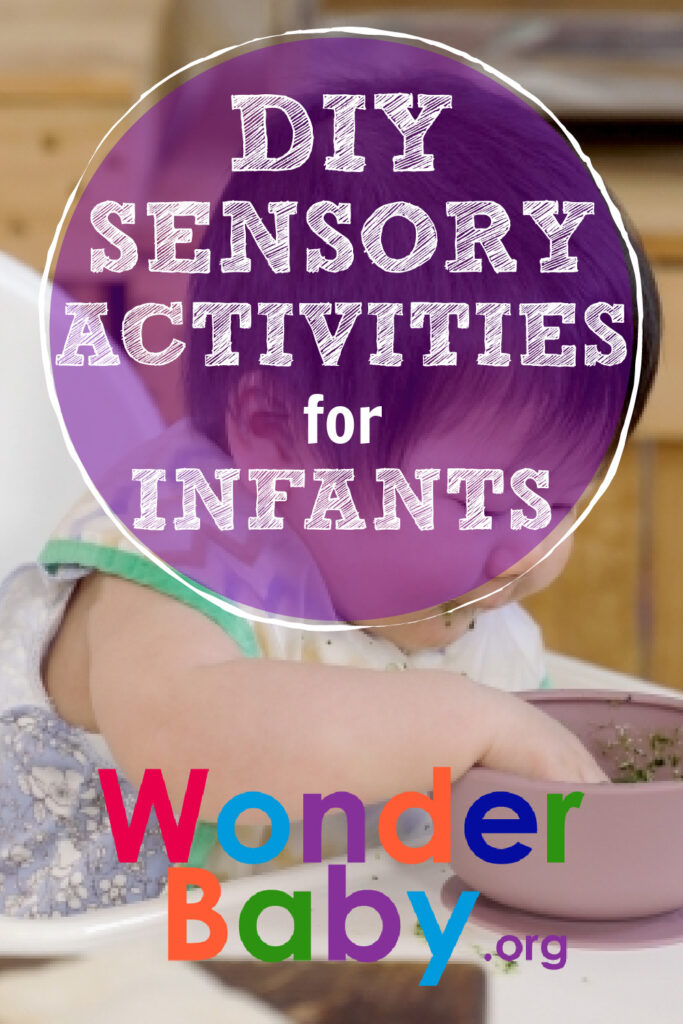
Related Posts
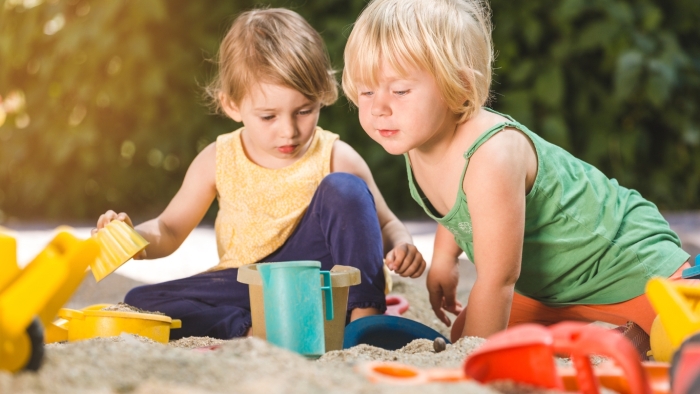
Sensory Activities
5 Sand Play Activities to Encourage Fine Motor Development
Sensory bin, at the beach, or in a sandpit? Try these sand play activities to help toddlers and preschoolers develop their fine motor skills.
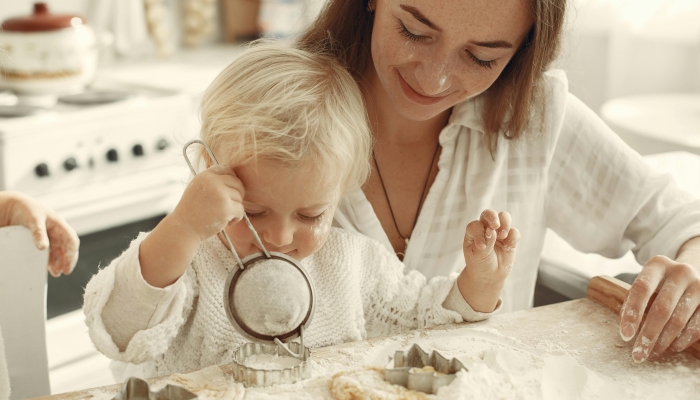
Sensory Activities
5 Edible Sensory Play Ideas
Check out our favorite edible sensory play activities to engage children's senses, boost their development, and provide hours of fun.
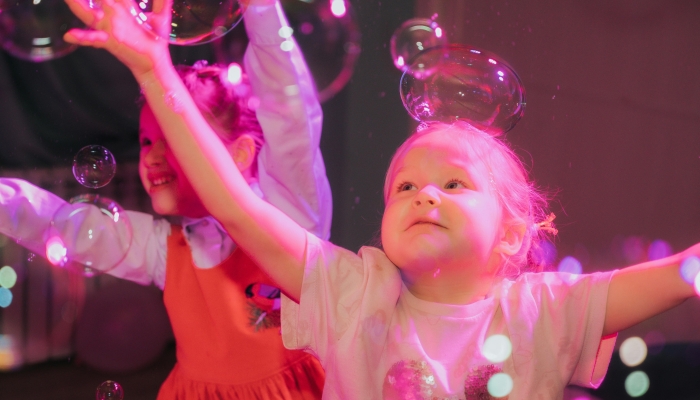
Sensory Activities
How to Make Unpoppable Bubbles
Discover the secret to making unpoppable bubbles with this easy guide. You only need three ingredients!